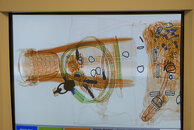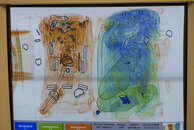DiveCaddy
Registered
- Messages
- 12
- Reaction score
- 0
Hi DiverSteve,How long are your fins?
Fully loaded how long is the entire bag? Some of the place I fly into are pretty firm about the 22" max. length.
Also, since I don't bring a wetsuit, how protected would the left side panel be for other gear. Like video cameras in soft packs etc. Assuming that it was always with me and not checked.
thx,
Great questions.
Re: fin length vs. published carryon limits.
The key with the bag system is that it's a soft, compression bag that will allow your gear to mould and flex to fit into the overhead compartment of commercial airliners. The fin tips can even curve a small amount, if needed, to fit inside the metal cages at check-in if you are ever challenged. (Feel free to view our actual airport videos on our website: divecaddy.net/index-7.html)
I have personally logged over 40 flights with prototype and production DiveCaddy systems and have only been stopped for TSA inspection a few times. Usually, the TSA techs are just curious as they have not seen this type of bag and it looks very technical. Also, when accompanied by other obvious looking dive gear (fins, mask, etc.) the TSA techs recognize the 1st stage and reg hardware. By design, the whole inspection process only takes a minute or two because of the way the bag rolls out and buttons back up so easily.
Of the 40+ flights, I have never had an issue getting onto a plane with a DiveCaddy. I have chosen to gate-check, checking the bag at the gate, a few times which contrary to popular belief is completely different than checking a bag when you first come into the airport. When you gate check is not weighed and goes on with the car seats, strollers and wheelchairs, etc., in a different part of the cargo hold away from the other luggage. By gate checking you also eliminate the opportunity for the rouge airline employee to pilfer or break your gear or be charged checked bag fees. You also get your gear as you exit the plane. "Last on, first off".
Re: camera soft packs
I would experiment with the bag to see what works for you and your gear. Just remember, the left side (where the wetsuit usually goes) is also the padding for the bag in the backpack configuration. Lumpy, rigid items in that location may be uncomfortable. Depending upon the size of your camera system, we usually treat our SLR's and lenses as our "Personal item" and slide them under the seat in front of us and put the DiveCaddy in the overhead. Most of the time there is extra room in the overhead to slip the camera case in after everyone has settled on the plane.
Please feel free to post, email or call our offices anytime; we're here to help you protect your gear and save money.
(I attached a couple images to give you an idea what the TSA techs are seeing with the X-Ray)
Happy travels,
Chad
DiveCaddy





